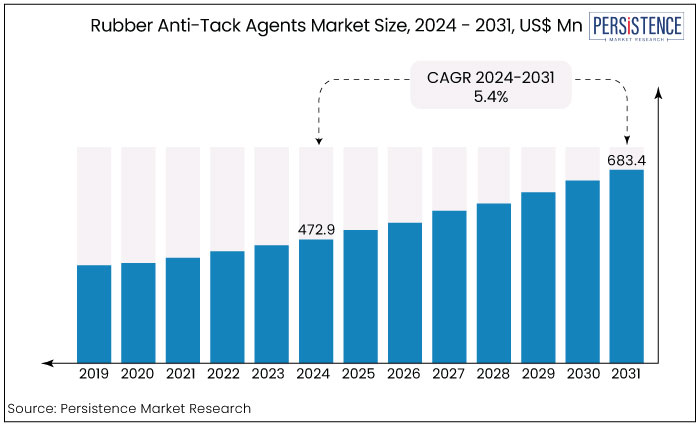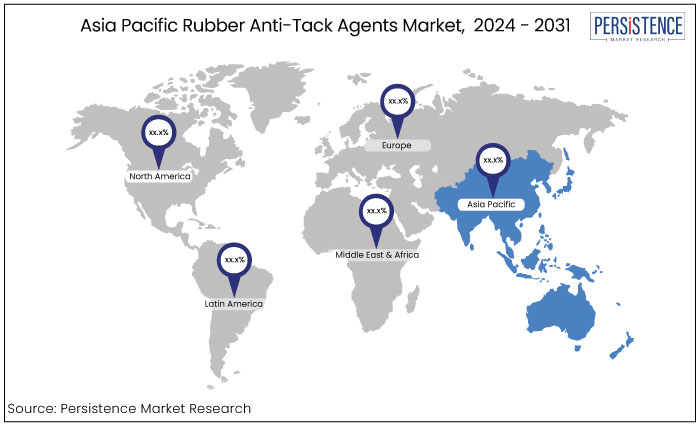PMR Anticipates a Healthy Demand Surge for Rubber Anti-Tack Agents Based on Growing Awareness of Industries About their Benefits, and Rising Demand from Tire Manufacturers
Industry: Chemicals and Materials
Format: PPT*, PDF, EXCEL
Delivery Timelines: Contact Sales
Report Type: Ongoing
Report ID: PMRREP14881
The global rubber anti-tack agents market is expected to rise from US$472.9 Mn in 2024 to US$683.4 Mn by the end of 2031. The market is anticipated to secure a CAGR of 5.4% during the forecast period from 2024 to 2031.

Key Highlights of the Market
|
Attributes |
Key Insights |
|
Market Size (2024E) |
US$472.9 Mn |
|
Projected Market Value (2031F) |
US$683.4 Mn |
|
Forecast Growth Rate (CAGR 2024 to 2031) |
5.4% |
|
Historical Growth Rate (CAGR 2019 to 2023) |
4.2% |
The rubber anti-tack agents are compounds falling under rubber processing chemicals that are used for eliminating issues related to manufacturing. These agents also enhance the operational efficiency of production processes of various types of rubber based products.
The rubber anti-tack agent is used for preventing the uncured rubber compound from sticking together while storage. These agents are generally available in liquid as well as slurry forms with fatty acids specifically for rubber sheets, pellets or strips.
Manufacturers are providing the rubber anti-tack agents in the form of extensive line of slurries and pastes customized to meet the unique requirements of the end users. They are also focusing on producing anti-tack agents, which provide bets performance while meeting sustainability criteria.
These agents also prevent any changes in the chemical composition of rubber that can affect the vulcanization time, viscosity and stickiness of the rubber compound.
Expanding aviation industry, coupled with increasing air traffic requires the utilization of such agents for smooth operations at airports. The demand for efficient anti-tack is expected to increase with airports attempt to reduce downtime and maintain operational efficiency.
Asia Pacific is a leading rubber producer. Demand for rubber anti-tack agents in the region is estimated to remain high. Regional market growth is owing to the requirement of rubber anti-tack agents to be applied in agitated and non-agitated tanks providing non-sticky surface for a wide range of rubber based compounds.
Key players in the market are looking forward to improve their profitability through new product development and technological innovations. There is an increasing need for solutions, which lessen the adverse effects of rubber deposits left behind by tires as well as a few rubber-based products.
The market for rubber anti-tack agents has shown steady growth during the historical period. The market has benefited from the Growing industrial sectors including aerospace, automotive, and electronics.
The market has expanded in the past period with the growing adoption of anti-tack agents in emerging and developed economies. The market expanded at a CAGR of 5.4% during the historical period.
Market expansion has been supported by the growing awareness regarding the advantages of using anti-tack agents and the end-user industries’ growth.
The market is poised for continued growth in the forthcoming years fueled by various factors such as growing automotive industry. It is a key consumer of rubber components and tires.
The growth is estimated to fuel the demand for anti-tack agents in tire manufacturing as well as other automotive applications.
Sales of anti-tack agents are estimated to exhibit the sales of 5.4% during the forecast period from 2024 to 2031.
Growing Demand for Rubber Anti-Tack Agents from Automotive Industry
An extensive usage in automotive industry is one of the key drivers for rubber anti-tack agents industry across the globe, specifically in the developing and fast-developing economies.
The key economies include China, India, Singapore and other countries located in Asia Pacific, driving the demand for automotive products.
Rubber anti-tack agents are crucial to provent the sticking of rubber components during production processes in industries including automotive manufacturing.
These agents ensure that rubber parts do not adhere to molds, equipment, or each other, hence augmenting manufacturing efficiency and reducing downtime.
The demand for anti-tack agents is expected to increase consistently to support production scalability and quality control owing to the global automotive industry expansion particularly in emerging markets where manufacturing activities are increasing.
Growing Manufacturing Sector across Various Verticals
The manufacturing sector across various verticals is growing at steep pace and is expected to accelerate the demand for rubber anti-tack agents required for non-tyre applications.
The applications majorly include machine components, industrial rubber products, medical equipment, and footwear.
Anti-tack agents are used in the electronics and electrical sectors to prevent the sticking of rubber seals, gaskets, and other components used in electronic devices, appliances, and electrical equipment.
The reliability and performance of these components depend on the precise application of anti-tack agents to prevent issues such as contamination or improper sealing due to rubber adhesion.
As consumer electronics and industrial equipment continue to evolve with technological advancements and increased demand, the requirement for effective anti-tack solutions is estimated to grow to ensure product quality and reliability.
in the medical and healthcare sectors, where precision and hygiene are critical, anti-tack agents play a vital role in the production of medical devices, and pharmaceutical packaging involving rubber components.
These agents help maintain sterility, prevent cross-contamination, and ensure the integrity of medical supplies, thereby supporting the stringent regulatory requirements and quality standards in the healthcare industry.
Shortage, and High Price of Raw Materials
One of the key restraints for the industry is the shortage and high price of raw materials, which necessitates strategic planning among manufacturers to thrive in this fluctuating market.
Moreover, there are several environmental concerns associated with rubber anti-tack agents related to the emission of volatile organic compound.
The restraints associated with rubber anti-tack agents can be offset by improving operational efficiencies and improving applications of rubber anti-tack agents.
The shortage of raw materials may intensify competition amid manufacturers competing for limited resources. Such competitive pressure can result into increased costs for anti-tack agents since companies pass on high production costs to consumers.
Increasing costs in competitive market can potentially reduce the demand, impacting the overall market growth. The high price of raw materials impacts the manufacturing cost of anti-tack agents.
Producers can struggle to maintain competitive pricing while facing increasing costs for necessary ingredients. Such situation can squeeze profit margins and consequently restrict the ability of companies to invest expansion and research and development.
Expanding Presence in New Geographical Regions
Expanding presence in new geographical regions within the rubber anti-tack agents market involves strategic planning and execution.
Key industry participants can leverage several opportunities to establish and grow their footprint in different parts of the world.
To identify regions with growing infrastructure development, industrial sectors and growing demand for anti-tack agents, thorough market research is conducted.
Analysing regulatory environments, market trends and economic indicators greatly help in prioritizing target regions.
Forming strategic partnership with agents, industry stakeholders and local distributors may hasten market expansion as well as market entry.
Partnerships offer access to local market networks, and established customer relationships easing rapid penetration and market acceptance.
Establishing local production partnerships and local manufacturers reduces logistics costs, improves supply chain efficiency and shortens delivery times.
Local production reinforces market existence by demonstrating commitment to the region and enhancing responsiveness to the demand of the customer.
Stearates to Record a Major Share in the Market
Stearates are expected to account for the significant share of the market over the projection period due to their widespread use as lubricants as well as stabilizers in rubber and plastic manufacturing industries.
Stearates hold over 39% of the market share as of 2024. The rubber and plastic processing industry is a leading end user of stearates. Stearates are also used as vulcanization aid in rubber processing.
Asia Pacific to be a Leading Regional Market for Anti-Tack Agents
Asia Pacific is the leading region in global rubber anti-tack agent market owing to its huge rubber production capacity, and the growing demand for personal and commercial vehicles.
Consequently, leads to high demand for tyres and rubber based products. Asia Pacific accounts for over 48% of the market and witnesses significant regional demand in the market for rubber.
ASEAN is the substantial rubber producer and hence generated high demand for rubber processing chemicals including anti-track agents.
Malaysia, Thailand and Indonesia are a few of the leading and largest countries and consumers of anti-tack agents because of their large-scale rubber production.
The rising income levels among middle class section of developing countries in Asia Pacific region has created a boom in the motor vehicle manufacturing and usage, thereby fueling the demand for tires and creating a positive impact on the market growth throughout the forecast period.
North America to be a Significant Contributor
North America is also projected to hold major share in the global rubber anti-tack agents market, mainly due to the reviving automotive industry in the region.
This region has significant industrial base across various sectors including automotive, aerospace, electronics, and manufacturing.
These industries are the leading consumers of rubber anti-tack agents for applications such as tire manufacturing, production of rubber seals and gaskets, and other rubber-based products.
The region continues to invest in infrastructure projects such as roadways, airports, and industrial facilities.
Anti-tack agents are prominent in such projects to maintain surface friction, prevent rubber deposits on runways and roads. Further, these ensure safety for transportation and industrial operations.

April 2024
April 2024 witnessed a significant collaboration between GHI Industries and a prominent regional distributor specialising in rubber additives. This partnership aims to streamline the distribution of GHI's cutting-edge rubber processing aids and anti-tack agents across targeted regions.
By leveraging the distributor's established logistics infrastructure and market knowledge, GHI anticipates heightened market visibility and accessibility, fostering stronger relationships with customers and driving business growth.
November 2023
In November 2023, DEF Chemicals forged a strategic distribution agreement with a leading global distributor. This partnership aims to expand the market reach of DEF's comprehensive range of rubber processing aids and anti-tack agents.
Leveraging the distributor's extensive network and expertise in the rubber industry, DEF anticipates accelerated penetration into key markets, facilitating easier access to its innovative solutions for manufacturers worldwide.
Companies focus on developing anti-tack agents that provide superior performance in preventing rubber adhesion, ensuring operational efficiency.
The market is dominated by leading global players who have established strong brand presence, extensive distribution networks, and a wide range of product offerings.
These participants typically invest heavily in research and development to innovate new formulations, improve product performance, and meet evolving customer demands.
Market expansion strategies, customer relationships, regulatory compliance and strategic partnerships are a few key strategies followed by the key players in the market.
The companies navigate these strategies efficiently to sustain growth, maintain leadership position and capitalize on emerging opportunities in a competitive market.
|
Attributes |
Details |
|
Forecast Period |
2024 to 2031 |
|
Historical Data Available for |
2019 to 2023 |
|
Market Analysis |
US$ Billion for Value |
|
Key Regions Covered |
|
|
Key Countries Covered |
|
|
Key Market Segments Covered |
|
|
Key Companies Profiled |
|
|
Report Coverage |
|
|
Customization & Pricing |
|
By Product
By Region
To know more about delivery timeline for this report Contact Sales

Increasing demand for rubber processing chemicals for nitrile gloves remains a key driver for market growth.
A few of the leading market players are Lion Specialty Chemicals Co., Ltd., King Industries, Inc., and FACI SPA.
Expanding presence in new geographical regions is a key opportunity in the market.
Stearates to gain larger share in the market.
North America is also projected to hold major share in the market.